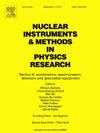Towards the T-SDHCAL hadronic calorimeter for a future Higgs factory
IF 1.5
3区 物理与天体物理
Q3 INSTRUMENTS & INSTRUMENTATION
Nuclear Instruments & Methods in Physics Research Section A-accelerators Spectrometers Detectors and Associated Equipment
Pub Date : 2025-04-18
DOI:10.1016/j.nima.2025.170520
引用次数: 0
Abstract
The CALICE technological RPC-based SDHCAL prototype that fulfills all the requirements of compactness, hermeticity and power budget of the future lepton accelerator experiments, has been extensively tested and has provided excellent results in terms of the energy resolution and shower separation. A new phase of R&D to validate completely the SDHCAL option for the International Linear Detector (ILD) project of the ILC and also the Circular Electron Positron Collider (CEPC and FCCee) has started with the conception and the realization of new prototypes. The new prototype proposes to exploit the excellent time resolution that can be provided by multi-gap resistive plate chamber detectors in order to better build the hadronic showers with the aim to separate close-by ones and also to single out the contribution of delayed neutrons with the purpose to improve on the Particle Flow Algorithm performances and better reconstruct the showers energy. A new technique to build multi-gap resistive plate chambers has been developed and first results confirm the excellent efficiency of the new detectors. The timing performance is under study using the PETIROC ASIC developed by the OMEGA group. The progress realized on the different aspects of the new concept will be presented and the future steps will be discussed.
用于未来希格斯工厂的T-SDHCAL强子量热计
基于 CALICE 技术 RPC 的 SDHCAL 原型满足了未来轻子加速器实验对紧凑性、密封性和功率预算的所有要求,已经过广泛测试,并在能量分辨率和骤雨分离方面取得了优异成绩。为了全面验证用于国际直线加速器(ILC)的国际直线探测器(ILD)项目和环形电子正负电子对撞机(CEPC 和 FCCee)的 SDHCAL 选项,新一阶段的研究与开发工作已经开始,新原型的构思和实现工作也已启动。新原型计划利用多间隙电阻板室探测器提供的出色时间分辨率,更好地建立强子簇,以便分离近距离的强子簇,并找出延迟中子的贡献,从而提高粒子流算法的性能,更好地重建强子簇的能量。已经开发出一种建造多间隙电阻板室的新技术,初步结果证实了新探测器的出色效率。目前正在使用 OMEGA 小组开发的 PETIROC ASIC 研究定时性能。将介绍在新概念的不同方面取得的进展,并讨论未来的步骤。
本文章由计算机程序翻译,如有差异,请以英文原文为准。
求助全文
约1分钟内获得全文
求助全文
来源期刊
CiteScore
3.20
自引率
21.40%
发文量
787
审稿时长
1 months
期刊介绍:
Section A of Nuclear Instruments and Methods in Physics Research publishes papers on design, manufacturing and performance of scientific instruments with an emphasis on large scale facilities. This includes the development of particle accelerators, ion sources, beam transport systems and target arrangements as well as the use of secondary phenomena such as synchrotron radiation and free electron lasers. It also includes all types of instrumentation for the detection and spectrometry of radiations from high energy processes and nuclear decays, as well as instrumentation for experiments at nuclear reactors. Specialized electronics for nuclear and other types of spectrometry as well as computerization of measurements and control systems in this area also find their place in the A section.
Theoretical as well as experimental papers are accepted.

 求助内容:
求助内容: 应助结果提醒方式:
应助结果提醒方式:


